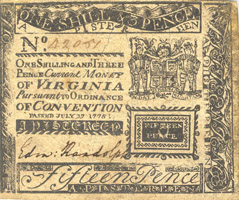Virginia Currency: The Pistereen

The paper currency given to Questors is a "pistereen," which was a Williamsburg printer's mispelling of the Spanish "pistareen" that equaled two Spanish reales. Such foreign currency—which was usually in the form of a coin, rather than paper, widely circulated in the British American colonies for much of the 18th century and played a critical role in Virginia's economy.
A pistereen's lawful value was set at 15 pence (which is 1 shilling and 3 pence) of the "Current Money of Virginia." The money that Questors use was produced by an act of the 5th Virginia Convention on July 17, 1775, just a few weeks after it created a new republican government on June 29. It authorized the printing of £350,000 Treasury Notes redeemable by January 1, 1784, and issued in a range of denominations from the single pistereen that Questors use to a note worth 12 crowns (£3). Each paper was signed by a Virginia official, including Edmund Randolph, the attorney general of the newly independent commonwealth.
The pistereen is described as "Current Money of Virginia" to distinguish it from the value of British money, which was (and is) designated as "sterling" and worth as much as 33 percent more (today, coincidentally, the value of the American dollar consistently hovers around two/thirds that of the British pound). While the value of modern currencies are determined by international markets, in the 18th century merchants met in Williamsburg every few months at the "Exchange" between the Capitol and the Coffeehouse to set the difference between the "current" value of Virginia money and the standard value of British money. Their decisions were then printed in the Virginia Gazette.
In Williamsburg in 1776, a pistereen could purchase 2 dozen metal buttons or one ounce of thread.



